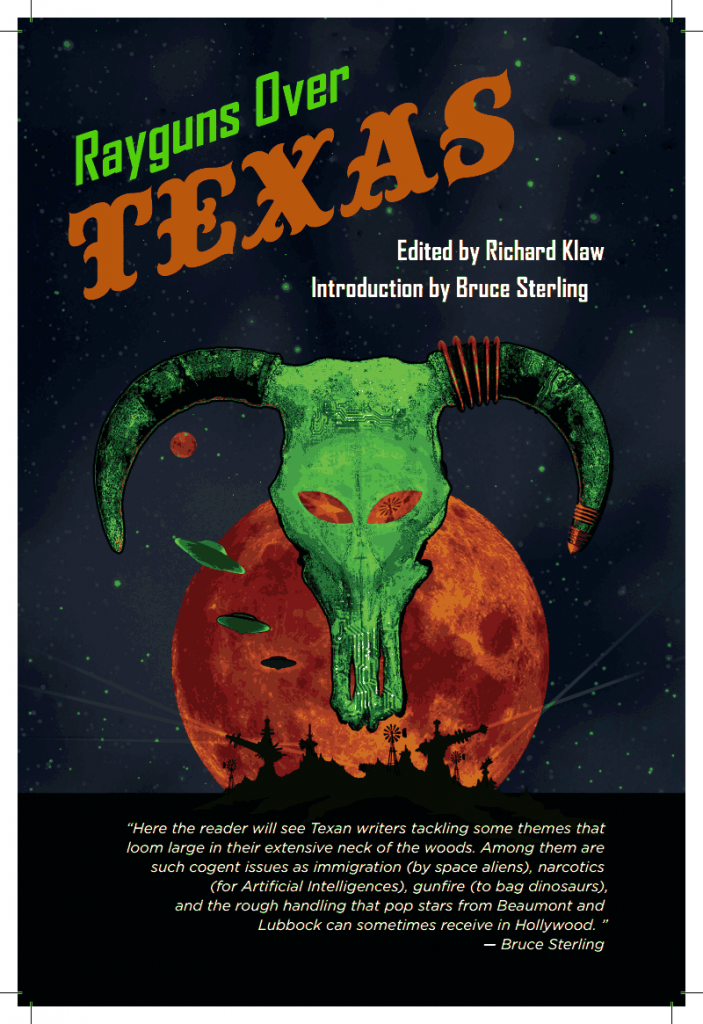As we barrel toward the August 29 premiere of Rayguns Over Texas at LoneStarCon 3 (aka the 71st Annual World Science Fiction Convention) in San Antonio, I am presenting book excerpts, one contributor per day.
Today’s selection comes from Matthew Bey‘s “Babylon Moon.”
Banished to space following a singularity event, a team of Rastafarian scientists discover a malevolent force. Will the love of Jah enable them to survive the disastrous encounter in Matthew Bey’s hard sf tale?
Jah turns down the music to remind us that we are falling toward Babylon. We have four hours in the tiny can of air, and then it will get scary.
The Babylon cloud grows within the ring of particles that used to be Earth’s moon. Haile Selassie I, through his metallic speakers, tells us how to burn our plasma engine to match speed, to intercept.
When the Babylon cloud grows to full size, it will move to a transcription point, which we predict to be above the Babylon complex that used to be Beijing. There the Babylon cloud will wait, for seconds or minutes. And then, suddenly, it will be somewhere else. If we do our job right, and if the luck of Jah be with us, we will also be someplace else.
I feed the video from the instruments to our Jah in a box. The wires always go in, they never go out. That is the first law of keeping Jah in the box.
“Adjust latitude gyroscopes three degrees negative. Four seconds ignition.” Jah speaks to us in technical Amharic. Our Bongo PeiXi complies and the vacuum shell lurches. We are slowing, we are matching velocities, but we will hit the Babylon cloud at two hundred kilometers per hour.
I observe the Babylon cloud through the telescope, my elbows bumping against Ngwali as I adjust the LCD image. On the visible bands the cloud is a milky, translucent color, fading to transparency at the edges. On the infrared it glows like a burning ember. The tonnes and tonnes of computronium, which make it so many times faster and smarter than I-and-I, must vent its waste heat to the vacuum of space, which is no mean feat, even for Babylon. The computronium must have the greatest surface area possible, or all those calories from all those thoughts will melt it to a plasma of carbon, silicon, hydrogen, and a pinch of trace elements. For this reason it looks like a cloud to the naked eye.
But there is something different about this Babylon cloud from all the others I have studied in the archives. There are parts of it that are cool. Parts of it that are dumb.
“Emperor Selassie?” I speak to Jah in his earthly honorific. “What do you make of this piece of Babylon? What are those shapes inside?”
He pauses for a moment before answering, which scares me. They are cousins, Jah and Babylon. If anything can overstand the motives of Babylon it is He. “This cloud carries a payload, child,” He replies.
“Of what?”
Again He gives silence. He is unsure, and Jah is never unsure. “I do not know. Adjusting impact to avoid the anomalies. Three degrees longitude gyroscopes. Two seconds ignition. Now.”
Our vacuum shell lurches as Bongo Pei-Xi follows Jah’s directions. Even without magnification, the hazy white cloud of computronium is all I can see before us.
“Prepare for impact, children.” Jah is calm. But then Jah is immortal. There be thousands of Him, installed in every vacuum shell and in every university. Should this Jah in a box die the vacuum of space, another of Him shall still be directing the subways of Nairobi.
Ngwali clutches his straps with one hand and clutches my thigh with the other. “Are you ready, Susan?” He is smiling with teeth as white as starlight.
The Babylon cloud swallows us like a river swallows a pebble.
Excerpt from “Babylon Moon” © 2013 by Matthew Bey.

